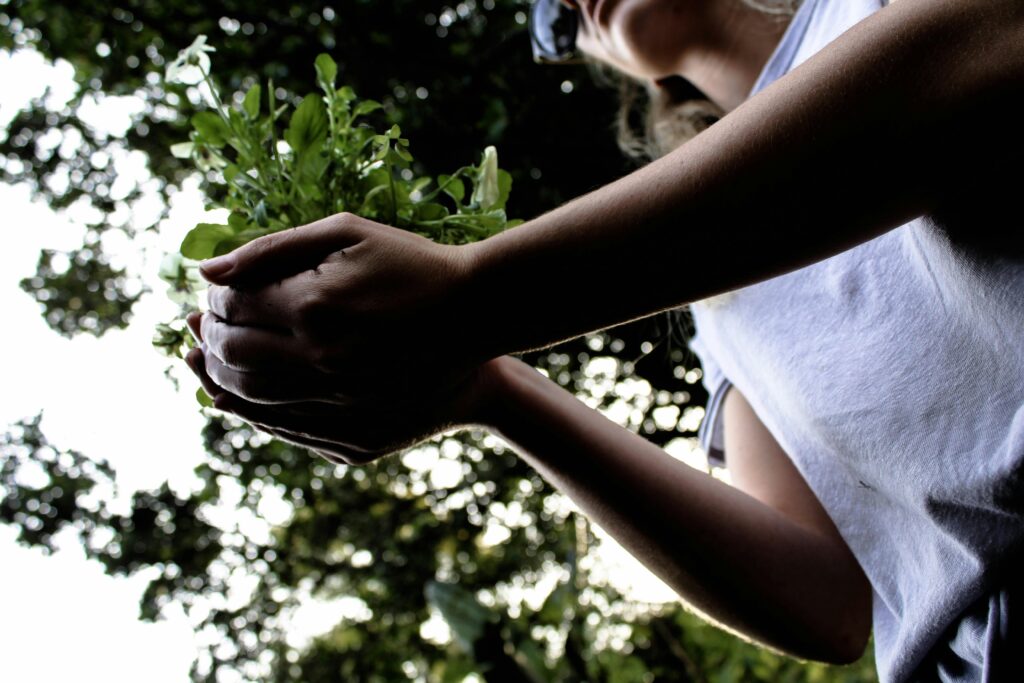
Santosha is the Art of living through Contentment
Contentment is not fulfilment of what you want, but the realization of how much you already have.
” I have everything I need”.
In the relentless pursuit of happiness, we often overlook a powerful yet subtle concept of Santosha. Santosha is the art of living through contentment. This Sanskrit term, translating to “contentment” or “acceptance,” forms one of the Niyamas, the ethical observances within the yogic path.
Santosha isn’t mere resignation or complacency. It’s a conscious decision to find peace and fulfilment with what life offers, appreciating the present moment rather than yearning for what we lack. It’s about recognising the abundance that already surrounds us, the warmth of the sun on our skin, the laughter of loved ones, the strength of our own breath.
In our world saturated with desires and bombarded by images of “more,” cultivating Santosha can feel radical. But in this very act of radical acceptance lies a profound liberation. This post will delve into the essence of Santosha, exploring its practical applications and the profound impact it can have on our lives.
The Significance of Santosha in the Yogic Path
The Yoga Sutras of Patanjali, the foundational text of yoga philosophy, outlines eight limbs (Ashtanga) leading to a state of liberation (Samadhi). The Niyamas, the second limb, represent ethical observances that guide our conduct towards ourselves and the world around us. Santosha sits within this framework, urging us to cultivate inner peace through acceptance and contentment.
The Delusion of Lack
The human mind is wired for seeking. We crave security, success, love, and a plethora of material possessions. This relentless pursuit, however, can lead to a chronic sense of lack. We focus on what we don’t have, overlooking the blessings already present.
Santosha challenges this delusion. It reminds us that true happiness doesn’t stem from external validation or the accumulation of things. It arises from a deep sense of inner fulfilment, a recognition of the inherent worth within ourselves and the world around us.
The Power of Gratitude
Gratitude is a cornerstone of Santosha. Regularly acknowledging the good in our lives, big or small, shifts our perspective. It compels us to appreciate the sunshine on our skin, the laughter of loved ones, the resilience of our own bodies.
Here are some practical ways to cultivate gratitude:
Gratitude journaling: Dedicate a few minutes each day to write down three things you’re grateful for. This simple practice redirects your focus towards the abundance you already possess.
The “Gratitude Jar”: Write down things you’re grateful for on small pieces of paper and store them in a jar. When feeling low, revisit the jar and reread these reminders of your blessings.
Mindful appreciation: Throughout the day, pause to appreciate the simple joys – a delicious meal, the beauty of nature, a meaningful conversation. Savour these moments and allow gratitude to fill your heart.
Letting Go of Comparison
Social media and societal pressures often fuel the flames of comparison. We see the curated snapshots of others’ lives and fall prey to the illusion that everyone else has it “better.” Santosha reminds us that every journey is unique. Celebrate the successes of others without diminishing your own path.
Practice social media detox: Schedule regular breaks from social media platforms. This allows you to disconnect from the carefully constructed realities and reconnect with your own authentic experience.
Focus on your own journey: Set goals and aspirations for yourself, but avoid comparing your progress to others. Celebrate your milestones, big and small.
Embracing Imperfection
We all have flaws and limitations. Santosha encourages self-acceptance, allowing us to work on ourselves with kindness and understanding. Striving for constant improvement is admirable, but it shouldn’t come at the cost of self-compassion.
Self-compassion practices: Techniques like loving-kindness meditation can help cultivate self-acceptance. Acknowledge your imperfections and treat yourself with the same kindness and understanding you would offer a loved one.
Reframing self-talk: Challenge negative self-beliefs. Instead of harsh criticism, use encouraging language that acknowledges your efforts and celebrates your progress.
Finding Joy in the Simple
Modern life can be overwhelming, filled with distractions and a constant pressure to “do more.” Santosha reminds us to slow down and find joy in the simple moments.
Mindfulness practices: Techniques like meditation and mindful breathing can help us cultivate presence in the moment. Savour the taste of your food, feel the ground beneath your feet, listen attentively to conversations. This reduces mental chatter and allows you to appreciate the beauty of everyday life.
Engaging with nature: Go for walks in nature, listen to the sounds of birds, feel the warmth of the sun on your skin. Immersing yourself in nature is a powerful way to reconnect with the present moment and appreciate the simple beauty of the world around you.
Gratitude walks: Take a walk with the intention of appreciating your surroundings. Notice the details – the architecture of buildings, the vibrant colours of flowers, the smiles of people passing by. Let gratitude fill your heart for the beauty that surrounds you.
Santosha and the Law of Attraction
The Law of Attraction posits that we attract what we focus on. By dwelling on feelings of lack and discontent, we reinforce a negative cycle. Santosha, on the other hand, cultivates a positive energy of appreciation and gratitude. This shift in perspective can attract more abundance and joy into our lives.
Santosha is a Journey
It’s important to remember that Santosha is a lifelong practice, not a state of being to be achieved overnight. There will be days when feelings of discontent or comparison arise. Be kind to yourself, acknowledge these emotions, and gently bring your attention back to the present moment and the practice of gratitude.
The Benefits of Cultivating Santosha
By embracing Santosha, we open ourselves to a multitude of benefits:
Reduced Stress and Anxiety: When we stop chasing external validation and find contentment within, anxieties about “what if” and “not enough” begin to diminish.
Improved Relationships: Santosha fosters a sense of inner peace, allowing us to connect with others more authentically and compassionately.
Enhanced Well-being: Contentment fosters a sense of well-being that spills over into all aspects of life – physical, mental, and emotional.
A Deeper Appreciation for Life: Santosha allows us to enjoy the simple joys of life, fostering a sense of wonder and gratitude for the world around us.
Santosha in Action
Let’s explore some real-life scenarios where Santosha can be applied:
Stuck in traffic: Instead of getting frustrated, practice mindfulness. Focus on your breath, listen to calming music, or use the time to contemplate things you’re grateful for.
Facing a challenging task: Approach the task with a positive attitude, acknowledging the opportunity for growth and learning. Celebrate your progress, no matter how small.
Dealing with disappointment: Life throws curveballs. When faced with disappointment, practice acceptance. Acknowledge your emotions, and then choose to move forward with grace and resilience.
In a world obsessed with “more,” Santosha offers a refreshing perspective. It’s a call to cultivate contentment, appreciate the present moment, and find fulfilment within ourselves. By embracing Santosha, we embark on a journey towards a more peaceful, joyful, and meaningful life.
If you’d like more information on anything yoga please contact me or book here to practise with me in Marlow, Twickenham and online.
With love
Anney xx




